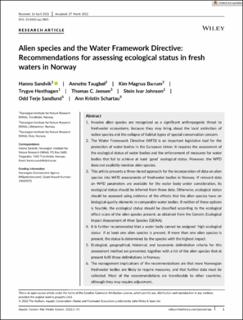| dc.description.abstract | 1. Invasive alien species are recognized as a significant anthropogenic threat to freshwater ecosystems, because they may bring about the local extinction of native species and the collapse of habitat types of special conservation concern. 2. The Water Framework Directive (WFD) is an important legislative tool for the protection of water bodies in the European Union. It requires the assessment of the ecological status of water bodies and the enforcement of measures for water bodies that fail to achieve at least ‘good’ ecological status. However, the WFD does not explicitly mention alien species. 3. This article presents a three-tiered approach for the incorporation of data on alien species into WFD assessments of freshwater bodies in Norway. If relevant data on WFD parameters are available for the water body under consideration, its ecological status should be inferred from those data. Otherwise, ecological status should be assessed using evidence of the effects that the alien species have on biological quality elements in comparable water bodies. If neither of these options is feasible, the ecological status should be classified according to the ecological effect score of the alien species present, as obtained from the Generic Ecological Impact Assessment of Alien Species (GEIAA). 4. It is further recommended that a water body cannot be assigned ‘high ecological status’ if at least one alien species is present. If more than one alien species is present, the status is determined by the species with the highest impact. 5. Ecological, geographical, historical, and taxonomic delimitation criteria for this assessment method are presented, together with a list of the alien species that at present fulfil these delimitations in Norway. 6. The management implications of the recommendations are that more Norwegian freshwater bodies are likely to require measures, and that further data must be collected. Most of the recommendations are transferable to other countries, although they may require adjustment. dispersal, ecological impact, freshwater bodies, invasive alien species, lakes, rivers | en_US |

